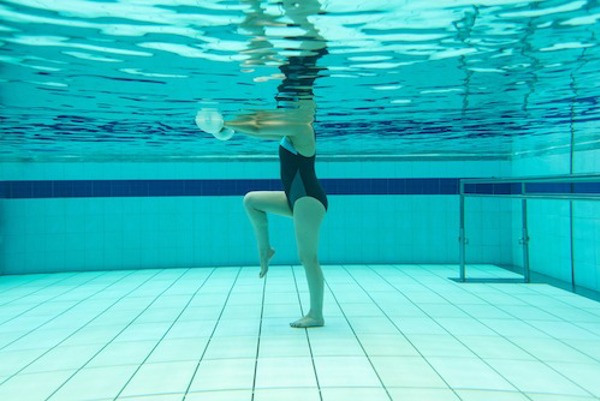Hydrotherapy with Sally Shannon
21 June 2022 | By Sally Shannon

Aquatic Physiotherapy – Why Water?
I discovered my love of aquatic physio quite by accident – early on in my career, I “inherited” a wonderful class of people who were managing various chronic health conditions with water-based exercise. Over my time there, I saw how beneficial this specific rehab was for patients with arthritis, lupus, chronic pain conditions and many others. An opportunity arrived a few years later to spend more time working in a hydrotherapy pool and I did not pass it up! After spending a few years as a predominantly land-based therapist once again, I am now back in the water and finding a happy balance between the two.
Hydrotherapy is not a new discovery by any means. Water has been used as a means of therapy since at least 2000 BC. Some of the main benefits include:
- Buoyancy – your body is supported, so the compression force through your joints is less. People with painful joints can often move more freely in water, making it a fantastic starting point in a rehabilitation programme
- Decreased pain – the warm water, the support it provides, the improved circulation it facilitates can all assist in reducing pain experienced with movement
- Better Range of Motion – some patients have difficulty getting full range of movement of particular joints when working against gravity. Water can provide support, allowing exercise through the joint’s complete range
- Strength training – While water can facilitate slow movements, it resists faster movement, creating a lot of resistance to strengthen weak muscles
- Stimulates balance – you have to work, however subtly, to stay upright in water. For those with balance challenges (e.g. stroke, Parkinsons, etc), large, expansive movements are more possible in water as it is a safe environment (provided a suitable person is present!) to risk falling
- Improved mood –Warm water can promote relaxation and, overall, water is fun!
Another more specific benefit of water-based rehabilitation is early weight bearing and gait-retraining. After some injuries, surgeries, fractures, etc, a period of non-weight bearing may be prescribed. It is often the case that your doctor will permit you to start walking in water at least a few weeks before you can start walking on land. This can help to reduce stiffness associated with immobility, reduce limping and start regaining strength and balance. Many famous athletes have utilised deep-water running programs while injured as a way of maintaining strength and fitness.
A few examples of clients that I’ve seen benefit from aquatic physiotherapy (names changed to protect privacy):
Larry is an ex-boxer with fairly advanced Parkinsons, manifesting with a significant tremor and increased tone in his muscles, leading to joint stiffness, pain and poor balance. While he requires assistance to walk on land, warm water helps to reduce some of the muscle tone and allow for larger movements, reducing joint stiffness and helping to manage his pain. Working in the water allows him to take larger steps, knowing he won’t be injured should he lose his balance. He can do some boxing drills in the water, working against resistance, taking some risks, enjoying some increased freedom of movement. On days where the tone and tremors are particularly bad, he can float on his back (supported with appropriate equipment), allowing the water to facilitate movement as well as having some hands-on manual therapy in the pool.
Raj survived a fall from a height that resulted in major lower limb injuries. He had progressed fairly well with his rehabilitation but was struggling to transition from using crutches to walking without assistance. He was referred for an aquatic program which included lots of strength and balance work as well as gait retraining. He transitioned slowly from chest deep water to knee deep water, ultimately managing to walk unaided on land.
Rose is an elderly lady who hasn’t done a lot of exercise for the last few years. She has remained very independent but recently had a fall which aggravated her lower back pain and restricted her mobility. This impacted her balance, ability to care for herself as well as causing her confidence to take a knock. She didn’t like the idea of getting into a swimming pool for the first time in years, but her doctor convinced her to give it a go. She started slowly… walking with support, testing her limits, but gradually gained confidence. She started to see improvements in her range of motion and balance, as well as her tolerance of strenuous activities (such as climbing stairs carrying her shopping). She plans on continuing with water-based exercise for as long as possible!
Where are we doing aquatic physiotherapy?
The Harold Holt Swim Centre has a wonderful hydrotherapy pool that is available for public use when not booked for private events. Sally see clients for individual sessions on a Tuesday and runs a two group classes on a Wednesday afternoon. Elliot also runs a group class late on a Wednesday evening. Some patients will usually require a “land” physiotherapy assessment at the practice before judging readiness for an aquatic programme. If you have a pool at home that you are able to get in and out of without much assistance, we can also arrange for a home visit (weather permitting!).
In summary, while water may not be for everyone, it is an often-overlooked resource that could be a valuable addition into your rehabilitation or exercise repertoire! Get in touch if you would like more information about how this could benefit you.
Sally is a physiotherapist at Kooyong Physiotherapy Centre and Spring Physio Gym. She completed her undergrad physio degree at the University of Cape Town. Some of the aquatic courses that she has completed include Aquatic Pilates workshops, an introduction to clinical Watsu and Peggy Shoedinger’s Advanced International Aquatic Therapy Techniques.
References:
Batterham et al.: Systematic review and meta-analysis comparing land and aquatic exercise for people with hip or knee arthritis on function, mobility and other health outcomes. BMC Musculoskeletal Disorders 2011 12:123.
Douris, P et al.: The Effect of Land and Aquatic Exercise on Balance Scores in Older Adults. Journal of Geriatric Physical Therapy 2003 26,1:03
Schoedinger, P. Advanced International Aquatic Therapy Techniques, Course Manual. 2016




